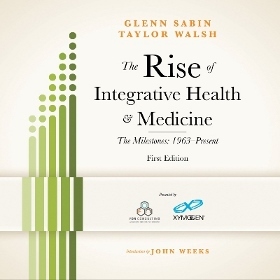The Economic Potential of Integrative Medicine
With a growing list of integrative medicine and integrative oncology centers and clinics in the U.S., and a recent report from Nutrition Business Journal stating that consumption of natural products and integrative medicine services is projected to reach $50B annually—those on the outside looking in would assume that it’s an exciting and lucrative time to be an integrative practitioner. Well, yes and no.
A combination of consumer demand, clinical outcomes and emerging literature supportive of a whole person integrative approach to medicine is leading to sustained growth in the industry. But the reality is that reimbursements from payers and the Centers for Medicare and Medicaid Services (CMS) for conventional care—especially for oncologists—keep shrinking, and integrative services are still largely not reimbursable. The economy is still biting the middle class; and those with decent insurance policies, Cadillac models and Chevy’s alike, often hesitate to pay out-of-pocket for medical services, especially those requiring repeat visits for chronic conditions.
Two key things need to happen over the next few years in order for evidence-based integrative care to become a sustainable economic model for centers and practitioners: comparative effectiveness research and the employment of 21st century marketing and communications:
Integrative care has to be proven as cost-effective
If proof of savings can be shown using comparative effectiveness research (CER) featuring “prescriptive” lifestyle programs, or even single interventions showing positive, affordable outcomes compared to today’s standard of care, then the government—the country’s largest payer—and insurance companies will slowly start getting behind these cost-saving options. Following are a few encouraging findings from 2010, as highlighted in John Weeks’ March 2011 Integrator Blog post, The Big Money in Integrative Health Care:
- Duke Prospective Health reports a $2200 per employee per year savings from an integrative approach.
- Dugald Seely, ND and researcher Patricia Herman, MS, ND, PhD of the Canadian College of Naturopathic Medicine reported preliminary outcomes of an individualized multi-modality intervention for employees of Canada Post at risk for cardiovascular disease. The initial findings were reduced risk and a projected savings of $1025 per postal employee.
- Penny George Institute reports that a preliminary analysis has found that their inpatient integrative care initiative is saving $2000 per patient per hospital stay for patients at Abbott Northwestern Hospital, part of the Allina system.
- Aetna partnered with Duke Integrative Medicine on a randomized controlled pilot study comparing stress reduction using yoga for a group of volunteer Aetna employees against a control. Early findings show an annual savings of $2000 per employee, by incorporating yoga for their most stressed employees. The studies have continued into 2011.
The National Prevention and Health Promotion Strategy was created by the Council on Prevention, Health Promotion, and Integrative and Public Health, as part of the Affordable Care Act, with the unprecedented goal of shifting the nation from a focus on sickness and disease to one based on wellness and prevention. Imagine dietician consultations covered one day for cancer patients or even well patients—and not just for those with heart disease or type 2 diabetes! The hope is for a well-designed integrative medicine arm to be part of every viable CER trial funded through the Affordable Care Act. Until positive outcomes from studies such as those done at Penny George Institute and Duke can be duplicated within a CER setting, legislators on capital hill will simply not pay much attention. The integrative medicine proponents on the advisory council clearly have their work cut out for them.
Providers of Integrative Care Must Become Sophisticated Marketers and Communicators
A course of watchful waiting or hoping for payers, including CMS, to help relieve health consumers and begin reimbursing your center for the integrative services you provide is not a viable business model.
Action and behavior change is required now, to ensure that providers of evidence-based integrative care can enjoy the economic benefits that should come along with the satisfaction of helping patients with a true patient-centered approach to medicine. You need to get paid for providing your conventional and integrative services. Perhaps your practice has gone the direction of a concierge model and it’s working for you just fine. That’s wonderful, but most integrative practitioners don’t have this luxury—yet—and need to become savvy marketers and communicators.
Here are a few concepts:
- Internal Referrals: If you are a part of a practice, center or institution and have colleagues that solely practice allopathic care, share what you do, how it benefits patients and most importantly, share the literature.
- External Referrals: Create a strategy within your community to communicate to conventional practices about your clinic or center. Explain how their patients can benefit from your services and achieve better outcomes, i.e. mindfulness-based stress reduction during cancer therapy, yoga or acupuncture to relieve pain and perhaps lessen the use of pharma and nutrition consults to increase immune function. Provide quality collateral material about your center and share the medical literature in support of the services you provide.
- Experiential Programming Content: You don’t have to be UCLA or M. D. Anderson to create and deliver a lecture series on integrative medicine. You can do this at your center on a Saturday, or tie in with a local health-oriented media outlet that can promote your series. Exposing prospective patients to quality information about integrative medicine will build around your brand—you and your center—and make consumers more inclined to visit your clinic. This is called experiential marketing.
- Content Marketing: Just like experiential programming content, but not live. If your Web pages are static, you are missing the boat on driving organic traffic to your site. You might have a well-designed site and solid messaging about your staff and services, but at the end of the day, this serves as a shingle of yesteryear for folks to happen upon. You need a blog, you need fresh news and other content built into a content calendar; and you need to deliver it on a consistent basis. Providing quality, useful information on a regular basis provides thought leadership and engenders trust with your audience. If done right, when they are ready to “buy”, they will think of you.
While we wait for the payers to come around, now is the time for you to implement an actionable marketing and communications strategy to improve the economics of your integrative practice.
About FON
FON is a leading integrative health and medicine business development and strategy consulting firm. FON specializes in custom solutions for growing patient volume, developing programs, and increasing product sales. Our practical business models are driven by innovative marketing, clear messaging, and customer engagement via branded storytelling.
Contact us today to schedule a complimentary 30-minute consultation to discuss your business development or personal brand needs.

Read Glenn’s story.

